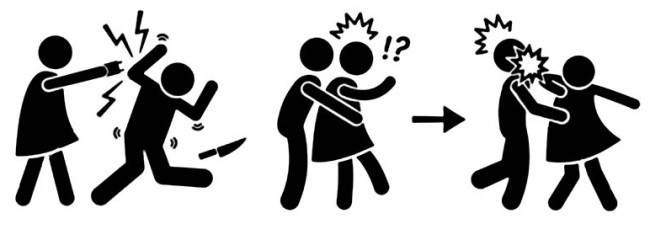I recently watched some of the TV series, “Kung-Fu” (1972-75) with my young son. It was my favorite when I was a teenager. The show’s hero, Kawi Chang Caine, never used force other than defensively. And if the issue could be solved without force, he took that route. A good role model.
In one episode, a Shaolin master told students the best defense was to run. Implicit in his instruction was, “…but only if you can do so safely”. Another good standard, and a match for NY law. I hope my son was paying attention.
In the face of illegal violence, the goal is to avoid harm, not to prove yourself the better fighter. There are times, however, when running is not an option. Maybe you are with someone who needs your protection, or turning your back would tactically be a dangerous move.
The use of physical force is allowed in NY under the doctrine of “justification”. Justification does not excuse an otherwise criminal act. The law acknowledges the use force is lawful under certain circumstances. But when in a public place, there is a duty to retreat before using force if—and only if— retreating can be done safely.
There is no duty to retreat in one’s home or in a dwelling you are rightfully in. You are not required to run out the back door when a burglar comes in the front. Known as the “Castle Doctrine” in some areas (as in “a person’s home is their castle”), the law allows you to stand firm in your home against illegal force. But you are still required to use only “reasonable” force in defense. As they say, the devil is in the details. What is reasonable? The answer will depend upon the facts and persons involved in each case.
Reasonable force is that degree of force which is enough to counter the illegal force being directed against you. It must be proportionate to the threat. Unreasonable force can be obvious, as in the Monty Python skit about the hunter fighting mosquitoes with a bazooka. Other cases can be closer calls.
You can’t use deadly force to respond to “ordinary” (non-deadly) force. Deadly force is that which is capable of killing or causing crippling injury. In order to use deadly force in self-defense, you must have a reasonable belief you are in imminent danger of suffering death or grave bodily injury (same applies to your defense of other innocents). The attacker must have the ability and opportunity to inflict death or grave bodily harm, and you must be in immediate jeopardy.
Next time, we will go into detail and I will give examples of some cases. By now, I’m sure you see how one topic easily leads to another, and to another…
Due to time constraints, law school only covers some areas superficially. Criminal law is just one course, and justification is only a small part of the subject. Fortunately, there are those who have made this their life’s study and have shared their expertise with defense lawyers, prosecutors, law enforcement, and law abiding citizens.
The person who I have studied the subject of defensive use of force with is Massad Ayoob. He is a pioneer in this field. His expertise has been recognized by courts across our nation. He served for 30 years as a police officer, has published books, hundreds of articles, taught thousands of students, and served as co-chair of the Forensic Evidence Committee for the National Association of Criminal Defense Lawyers. Yes….defense lawyers love this guy just as much as cops do. That speaks volumes. I am grateful for everything I have learned (and continue to learn) from him. His latest book is Deadly Force—Understanding Your Right to Self Defense (available on Amazon and other outlets).

